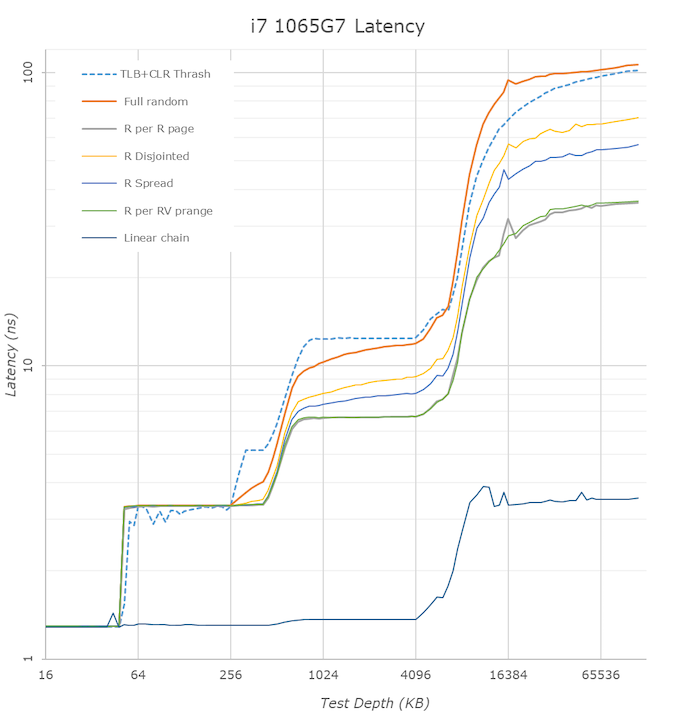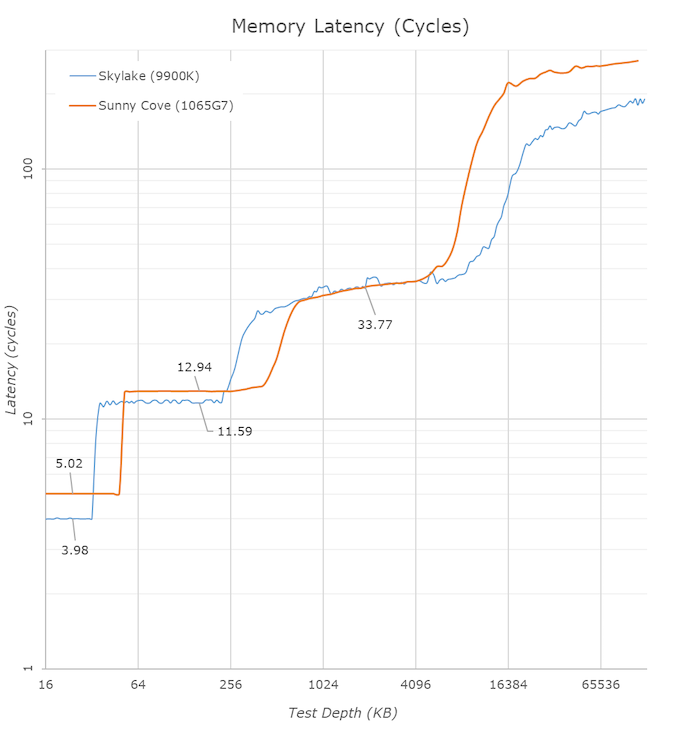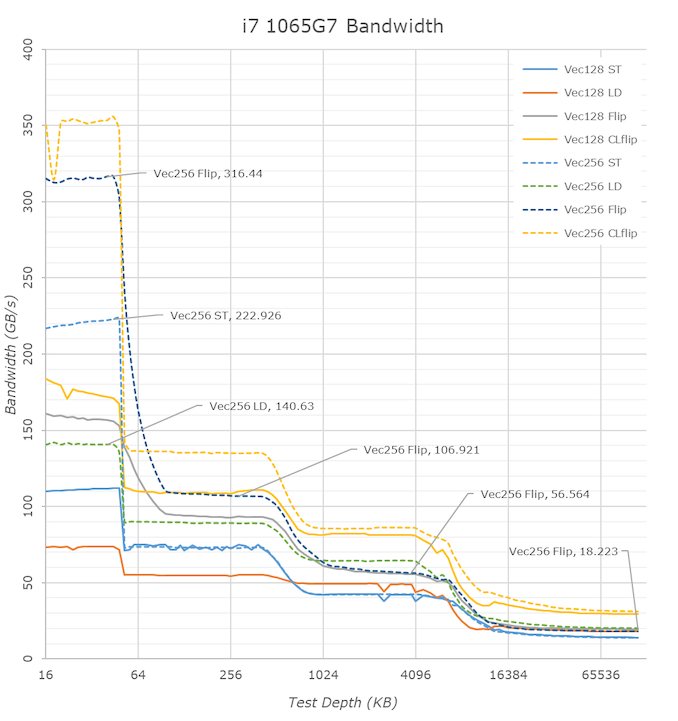The Ice Lake Benchmark Preview: Inside Intel's 10nm
by Dr. Ian Cutress on August 1, 2019 9:00 AM EST- Posted in
- CPUs
- Intel
- GPUs
- 10nm
- Core
- Ice Lake
- Cannon Lake
- Sunny Cove
- 10th Gen Core
Cache and TLB Updates
One of the biggest changes in the new Sunny Cove core is the cache hierarchy. Throughout most of the last decade, Intel has kept the same cache configuration among its server cores with very few changes, aside from improving the micro-op cache through Sandy Bridge today, but with Sunny Cove, we get some key updates.
From our microarchitecture disclosure article, we know that Sunny Cove brings with it an increased L1 data cache, as well as a doubled L2 cache, from Skylake. With this comes more associativity as well.
| Core Cache Comparison | ||||||
| Sunny Cove |
AnandTech | Cannon Lake |
Skylake | Sandy Bridge |
AMD Zen 2 |
|
| 48 KB 12-way |
L1-D | 32 KB 8-way |
32 KB 8-way |
32 KB 8-way |
32 KB 8-way |
|
| 32 KB 8-way |
L1-I | 32 KB 8-way |
32 KB 8-way |
32 KB 8-way |
32 KB 8-way |
|
| 512 KB 8-way |
L2 | 256 KB 4-way |
256 KB 4-way |
256 KB 8-way |
512 KB 8-way |
|
| 2 MB 16-way |
L3/core | 2 MB 16-way |
2 MB 16-way |
2MB 16-way |
4 MB 16-way |
|
| 2304 | uOp Cache | 1536 | 1536 | 1536 | 4096 | |
I’ve also included the size of the micro-op cache in this comparison, because we understand that the L1-I and the micro-op cache are typically located next to each other in the die design – increasing the size of one typically means limiting the size of the other, however given that both of them work to accelerate the same types of data, it is important to find the right balance: AMD for Zen 2 decided to halve the L1-I and double its associativity, and then double the micro-op cache from 2k to 4k entries. For Sunny Cove, Intel has increased the L1-D by 50%, but also increased the micro-op cache by 50%, taking advantage of the second generation 10nm process.
In the above latency graph comparison, we can notably see the new increased cache capacities. The L1’s increase from 32KB to 48KB is well visible, as well as the L2 increase from 256KB to 512KB.
On the part of the L2 it’s interesting to see that again the new core’s TLB structures don’t quite cover the whole capacity of the L2 and that’s why the latter half of the L2 has worse access latencies for L1D TLB miss patterns.
L3 latencies look similar, however we’ll dwell into that just in a bit. The DRAM latencies of course are apples and oranges in this case as Intel’s new LPPDR4X memory controller in the new ICL part doesn’t have a counter-part we can compare to, but as expected the memory latency is notably worse than a desktop part so no big surprises there.
What’s rather disappointing however is that we’re not really seeing any kind of change to the prefetchers and our access patterns between the two microarchitectures look identical. We had expected Intel to improve in this regard, but alas it seems, at least for our test cases, there’s been no improvements.
One of the major balancing acts with cache sizes is also cache latency. The bigger the cache, the longer it takes to retrieve data from it – increasing associativity can do this as well. Intel for the longest time has cited a 4-cycle latency to its L1 cache, and a 12-cycle latency to its L2 cache. This changes, in quite a substantial way.
| Core Cache Latency (in cycles) | ||||||
| Sunny Cove | AnandTech | Cannon Lake |
Skylake | Sandy Bridge |
AMD Zen 2 |
|
| 5 | L1 | 4 | 4 | 4 | 4 | |
| 13 | L2 | 12 | ~12 | 12 | 12 | |
| 30-36 | L3 | 26-37 | 34 | |||
Due to the increase in the L1 cache, that 4-cycle latency is now a 5-cycle latency. Intel is hoping that its double L1 store bandwidth will help hide that latency, however adding 20% latency onto every data fetch is a heavy hit to take. This is why a lot of the rest of the core is also beefed up, so work can still continue to cover for this extra cycle. It is worth noting that Intel’s Atom cores in the past had an L1 latency of 3 cycles, however they have also since moved to 4-cycle.
The L2 also changes, from 12 cycles to 13 cycles. You can’t double a cache for free, and it is interesting to note here that now AMD and Intel share the same L2 cache size and the same associativity, however AMD has a cycle advantage on Intel. This has a knock on effect for L3 cache latency too, which has increased from ~26-37 cycles to ~30-36 cycles on Intel, from Skylake. The latency here isn’t uniform because the cache isn’t uniform, and accessing non-local L3 slices comes with a latency penalty, as say opposed to AMD’s uniform latency L3.
One of the biggest additions Intel was keen to make in our Sunny Cove microarchitecture disclosure is the increase in the L1 bandwidth. Based on our testing, Skylake’s L1 data cache was capable of 2x32-byte read and 1x32-byte write per clock. For Sunny Cove this has increased, but it gets a bit more complicated. In one clock Sunny cove can perform 2x64-byte reads and either 1x64-byte write, or 1x32-byte write, or 2x16-byte writes. So both reads and writes, at peak, have doubled with bit width, with the write configurations being a bit more complex.
We can see the direct effects of the bandwidth change in our bandwidth tests. The L1 store bandwidth is extremely evident as it measures in at 222GB/s on the ICL part, while only reaching 139GB/s on the 28% higher clocked 9900K. If we normalise for frequency, we indeed see a doubling of the store bandwidth of the new core.
The L2 cache bandwidth looks unchanged from Skylake – the part here lags behind with an equal amount to the frequency difference. Surprisingly, the L3 bandwidth fares quite well here and is almost at parity to the desktop 9900K even though the frequency difference. The DRAM bandwidth is inferior on the ICL mobile chip, but again that’s to be expected due to the apples and oranges DRAM architecture comparison.
Moving on to the TLB configurations, and it turns out that Intel has moved where this data is stored. This data is typically stored in CPUID.02h, however it is now found in CPUID.18h, and the info between different page sizes and capabilities is now given as subdivisions. The TLBs look as follows, and broken down into configurations:
| Sunny Cove TLB | |||
| AnandTech | Type | Entries | Associativity |
| L1-D | 4K | 64 | 4-way |
| L1-D | 2M | 32 | 4-way |
| L1-D | 1G | 8 | full |
| L1-I | 4K+2M | 8 | full |
| L1-I | 4K+2M+1G | 16 | full |
| L2 | 4K+2M | 1024 | 8-way |
| L2 | 4K+1G | 1024 | 8-way |
This means that for 4K and 2M L1-I entries, there are a total 8+16 = 24 possible, but only 16 1G possible. For 4K L2 entries, there are 1024 + 1024 = 2048 entries possible, however only 1024 each of 2M/1G are possible. The peak numbers align with what Intel has told us in our microarchitecture disclosure, however it is good to dive into what is possible.













261 Comments
View All Comments
eastcoast_pete - Thursday, August 1, 2019 - link
Ian and Andrei, thanks for the article (Ian) and the tests (both) ! My take on why Intel did this "we let you play (test) with our reference system is that they needed to show that Ice Lake is for real, has working graphics, and not another gimped chip that is send off to pasture like Whiskey Lake. Overall, it seems to be an okay step forward, nothing great, but a step forward. For me, the main benefit of this new generation is AVX 512, which can speed certain programs up quite a lot.Lastly, Intel will sell a lot of these, mainly because AMD doesn't have a real competitive solution out there that can take them on in the low and lower power mobile space.
DooMMasteR - Friday, August 2, 2019 - link
Which makes this unusual showcase even weirder...Intel is so far only planning a low power mobile release (either because of platform restrictions, Ryzen has shown that 7nm needs complex thermal management) or because of fab volume restrictions in 10nm.
In either case Intels benefit from this showcase is quite small since AMD has no real contender announced anyways.
At least when people where looking for pure SoC performance... and in any other case AMD can still compete quite well, but lacks product variety and quality, Huawei has shown that amazing Ryzen mobile devices are possible and Lenovo and others have shown how to do it wrong.
The_Assimilator - Thursday, August 1, 2019 - link
While it's great that Intel is being so open about ICL, the sad thing is that it only highlights how bare their cupboard is at the moment. This is their second attempt at 10nm, yet it's so obviously inferior to the ultra-refined 14nm, which makes it clear that despite Intel's half-decade of massive expense and effort, their 10nm node isn't salvageable.I predict we'll see 14nm desktop ICL parts for Christmas, but I'm far more interested in what happens after 10nm. Does Intel have a plan to use all the hard-won experience on this failed node to make their next shrink actually happen on time and on schedule, or is the company in so deep that its decision-makers can't see any alternative route?
ksec - Thursday, August 1, 2019 - link
Just looking at those numbers, Icelake, while on average may be 20% faster, it is in fact some of the work load manage to get 30 to 40+% IPC increase. That is quite astonishing. And depending on AVX512 usage it could get even more performance out of it.What we need to know is die size.
GPU has improved but stilll isn't good enough.
Phynaz - Thursday, August 1, 2019 - link
Nothing from intel will ever be good enough for you unless it’s stamped AMDKorguz - Thursday, August 1, 2019 - link
and by your own comments so far in this thread, nothing will ever be good enough for you, unless its stamped intel, whats your point ?Phynaz - Friday, August 2, 2019 - link
I was waiting for you to show up. I’ll bet I’ve bought more AMD chips than you can count.Korguz - Friday, August 2, 2019 - link
you have ?? that's great, good for you, you must be proud of your self, knowing you have more money then brains. my self.. would prefer to pay my mortgage, food, and other things that are neededPhynaz - Saturday, August 3, 2019 - link
Sorry, I forgot you’re poor.Korguz - Saturday, August 3, 2019 - link
sorry phynaz, not poor. just have better things to spend my money on, cause unlike you, i dont still live with mommy and daddy, cause the way you insult people, and call them names, you must be some 15 year old, as this is what children do. maybe you should go away, grow up, and come back when you can talk to people with out resorting to insults, and childish behavior. 90% of your posts in this thread prove this, nothing but insults, does this make you feel better, calling people names and insulting them ?